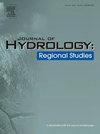Assessing drought conditions in Northeast Brazil: A comparative analysis of soil moisture, groundwater, and total water storage
IF 4.7
2区 地球科学
Q1 WATER RESOURCES
引用次数: 0
Abstract
Study region
Northeast Brazil (NEB).
Study focus
Over the past few decades, there has been a noticeable surge in the applications of drought indices centered around Total Water Storage (TWS) and its components. This study aims to evaluate the dynamics of continental water storage and its components in Northeast Brazil (NEB), utilizing drought indices based on soil moisture (SMI), groundwater (GWI) and TWS (WSDI) for the period 2003–2022. Four types of data were employed: remote sensing (ESA CCI SM and GRACE), in-situ data (SM and GW storage), land surface model simulations, and global Standardized Precipitation Evapotranspiration Index (SPEI). The first two served as the reference for comparison with the SM, GW, and TWS simulated by the Catchment Land Surface Model (CLSM).
New hydrological insights for the region: Drought indices based on CLSM data from the Global Land Data Assimilation System (GLDAS) can be considered reliable after comparison with SPEI and analysis of their patterns using continuous wavelet transformation (CWT). The SMI is more correlated with the SPEI-3 (3-month time scale), and the GWI presented better correlations with the time scales between 12 and 36 months of the SPEI. Changes in the trend of the indices were detected in the hydrographic regions localized in the south of the study area, indicating an increase in drought occurrence. The calculation of the TWS (doing the sum of SM and GW from the CLSM) fitted well with the GRACE data.
评估巴西东北部的干旱状况:土壤水分、地下水和总蓄水量的比较分析
研究地区巴西东北部(NEB).研究重点过去几十年来,以总蓄水量(TWS)及其组成部分为中心的干旱指数的应用明显激增。本研究旨在利用 2003-2022 年期间基于土壤水分(SMI)、地下水(GWI)和总蓄水量(WSDI)的干旱指数,评估巴西东北部(NEB)大陆蓄水量及其组成部分的动态变化。采用了四种类型的数据:遥感(欧空局 CCI SM 和 GRACE)、原位数据(SMI 和 GW 储存)、地表模型模拟和全球标准化降水蒸散指数 (SPEI)。前两者作为参考,与集水区地表模型(CLSM)模拟的 SM、GW 和 TWS 进行比较:基于全球陆地数据同化系统(GLDAS)CLSM 数据的干旱指数在与 SPEI 进行比较并使用连续小波变换(CWT)对其模式进行分析后,可以认为是可靠的。SMI 与 SPEI-3(3 个月时间尺度)的相关性更高,而 GWI 与 SPEI 的 12 至 36 个月时间尺度的相关性更好。在研究区南部的局部水文区域,发现了指数趋势的变化,表明干旱发生率有所上升。第三世界降水量指数的计算(通过 CLSM 计算 SM 和 GW 之和)与 GRACE 数据非常吻合。
本文章由计算机程序翻译,如有差异,请以英文原文为准。
求助全文
约1分钟内获得全文
求助全文
来源期刊

Journal of Hydrology-Regional Studies
Earth and Planetary Sciences-Earth and Planetary Sciences (miscellaneous)
CiteScore
6.70
自引率
8.50%
发文量
284
审稿时长
60 days
期刊介绍:
Journal of Hydrology: Regional Studies publishes original research papers enhancing the science of hydrology and aiming at region-specific problems, past and future conditions, analysis, review and solutions. The journal particularly welcomes research papers that deliver new insights into region-specific hydrological processes and responses to changing conditions, as well as contributions that incorporate interdisciplinarity and translational science.
 求助内容:
求助内容: 应助结果提醒方式:
应助结果提醒方式:


